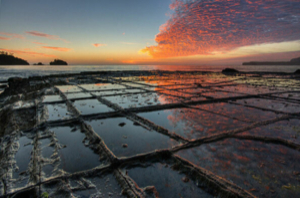 The isthmus connecting the Tasman Peninsula to Tasmania is covered in a pattern of regular rectangular saltwater pools. Although these depressions look distinctly manmade, they are the result of a rare type of natural erosion.
The isthmus connecting the Tasman Peninsula to Tasmania is covered in a pattern of regular rectangular saltwater pools. Although these depressions look distinctly manmade, they are the result of a rare type of natural erosion.
Occurring near sea coasts on flat rock which has broken into regular blocks, the effect is known as “tessellated pavement” for its resemblance to Roman mosaic floors (also called tessellated pavement).
 The pavement takes two forms. Depressions are known as pan formations, occurring when saltwater wears away the center portion of the stones into pools. The opposite effect is known as a loaf formation, when the edges of the stone are worn away leaving a rounded crown resembling rising bread.
The pavement takes two forms. Depressions are known as pan formations, occurring when saltwater wears away the center portion of the stones into pools. The opposite effect is known as a loaf formation, when the edges of the stone are worn away leaving a rounded crown resembling rising bread.
Tessellated pavements are extremely rare, found only in a few places on Earth. The geology is not related to the effect that created the Giant's Causeway in Northern Ireland and Fingal's Cave in Scotland. Those features were formed as basaltic lava cooled and fractured; tessellated pavement occurs as sedimentary rock erodes.
Taken from the website Atlas Obscura: To visit the website, click here...